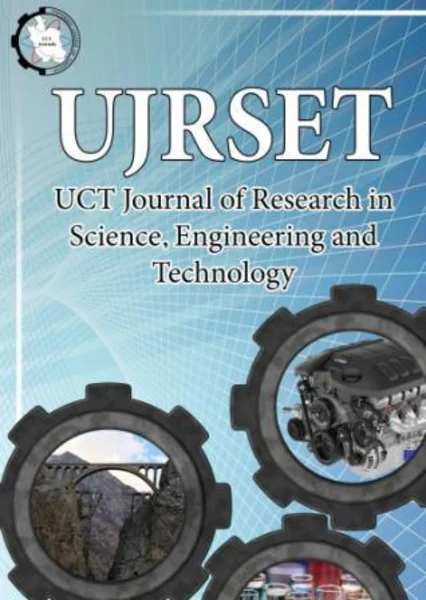-
investigation on effects of delay and acceleration in round up and accumulation of matured silkworm larvae and transferring them to cocoon making frames
جزئیات بیشتر مقاله- تاریخ ارائه: 1400/08/01
- تاریخ انتشار در تی پی بین: 1400/08/01
- تعداد بازدید: 455
- تعداد پرسش و پاسخ ها: 0
- شماره تماس ژورنال: 0989394668909
the aim of this experiment was investigation on effects of delay and acceleration in round up and accumulation of matured silkworm larvae in order to transferring them to cocoon making frames. three different ways of silkworm making cocoon-starting time was studied. the larvae hatching and rearing was conducted based on standard and similar methods. ttreatments were (1) treatment 1: the completion time of larvae feeding and larvae transfer from rearing tray to cocoon frame was standard and performed
individually based on larvae mature time; treatment 2: the completion time of larvae feeding and larvae transfer time from rearing tray to cocoon frame was 12 hours before larvae mature time; treatment 3: the completion time of larvae feeding and larvae transfer time from rearing tray to cocoon frame was 12 hours after larvae mature. production traits recorded and analyzed using generalized linear models procedure based completely randomized design model. from obtained results, it is showed that among studied
methods, the highest level of best cocoon number belonged to 2nd treatment (80.50), and 1st treatment (74.75) remained at lower level than other methods (p>0.05). among studied methods, the highest level of best cocoon alive pupae number belonged to 3rd treatment (79.75), and 1st treatment (71.25) remained at lower level than other methods (p>0.05). among studied methods, the highest level of best cocoon weight belonged to 3rd treatment (147.88 gr), and 2nd treatment (124.32 gr) remained at lower level than other
methods (p>0.05). among studied methods, the highest level of male cocoon shell percentage belonged to 3rd treatment (24.11%), and 2nd treatment (23.44%) remained at lower level than other methods. other methods were between these two groups (p>0.05). among studied methods, the highest level of male cocoon weight belonged to 3rd treatment (1.66 gr), and 1st treatment (1.64 gr) remained at lower level than
other methods (p>0.05). among studied methods, the highest level of male cocoon shell weight belonged to some treatments (0.443 gr), and 2nd treatment (0.38 gr) remained at lower level than other methods. other methods were between these two groups. meanwhile statistical differences between studied methods for this trait were not significant (p>0.05).
حوزه های تحت پوشش ژورنال
مقالات جدیدترین رویدادها
-
استفاده از تحلیل اهمیت-عملکرد در ارائه الگوی مدیریت خلاقیت سازمانی و ارائه راهکار جهت بهبود
-
بررسی تاثیر ارزش وجوه نقد مازاد بر ساختار سرمایه شرکت های پذیرفته شده در بورس اوراق بهادار تهران
-
بررسی تأثیر سطح افشای ریسک بر قرارداد بدهی شرکت های پذیرفته شده در بورس اوراق بهادار تهران
-
بررسی تأثیر رتبه بندی اعتباری مبتنی بر مدل امتیاز بازار نوظهور بر نقد شوندگی سهام با تأکید بر خصوصی سازی شرکت ها
-
تأثیر آمیخته بازاریابی پوشاک ایرانی بر تصویر ذهنی مشتری پوشاک ایرانی (هاکوپیان)
-
بررسی میزان مطلوبیت کلان شهر تهران از نظر زیرساخت شهر خلاق (مورد شناسی : منطقه 22 تهران)
-
بررسی تاثیر تغییرات اقلیمی بر عایق کاری دیوارشمالی و بام در ساختمان مسکونی
-
بررسی رابطه خود تمایزیافتگی و سبک تفکر با امید به زندگی در دختران فراری شهرستان شیراز
-
reliability assessment of shear in shortlink beam
-
comparison between kriging and inverse distance methods for improving extraction blocks grade control in sarcheshmeh copper mine
مقالات جدیدترین ژورنال ها
-
مدیریت و بررسی افسردگی دانش آموزان دختر مقطع متوسطه دوم در دروان کرونا در شهرستان دزفول
-
مدیریت و بررسی خرد سیاسی در اندیشه ی فردوسی در ادب ایران
-
واکاوی و مدیریت توصیفی قلمدان(جاکلیدی)ضریح در موزه آستان قدس رضوی
-
بررسی تاثیر خلاقیت، دانش و انگیزه کارکنان بر پیشنهادات نوآورانه کارکنان ( مورد مطالعه: هتل های 3 و 4 ستاره استان کرمان)
-
بررسی تاثیر کیفیت سیستم های اطلاعاتی بر تصمیم گیری موفق در شرکتهای تولیدی استان اصفهان (مورد مطالعه: مدیران شرکتهای تولیدی استان اصفهان)
-
بررسی اثرات استفاده از ضایعات میگو در جیره غذایی بچه ماهیان قزل آلای رنگین کمان (oncorhynchus mykiss) بر فاکتورهای خونی و سرمی
-
مطالعه آزمایشگاهی حذف فلز جیوه از آب با استفاده از غشای اولترافیلتراسیون ماتریس مرکب تیتانیوم دی اکسید، پلی سولفون
-
تاثیر استقلال حسابرس بر رابطه بین چرخش موسسه حسابرسی و پایداری سود
-
molecular docking of pyrazole inhibitors against integrase receptor: a computational quantum approach
-
role of urban management in development of seaside tourism with an emphasis on people participation case study: seaside city of juybar


سوال خود را در مورد این مقاله مطرح نمایید :